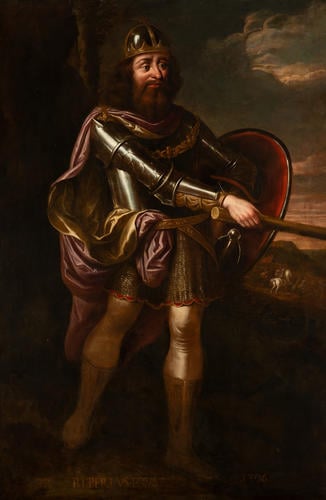Robert the Bruce, King of Scotland (1274-1329) 1684-86
Oil on canvas | 214.0 x 137.0 cm (support, canvas/panel/stretcher external) | RCIN 403358
-
The full-length image of the monarch is facing towards the right. He has been depicted wearing a chainmail armour skirt, a jacket and a mauve draped coat; he carries a shield on his left arm, and a staff in his right hand. Robert the Bruce was the scion of an aristocratic family embroiled in a succession dispute with the rival Balliols during the Wars of Scottish Independence (1296-1328). Bruce and his father supported Edward I’s invasion of Scotland in 1296 which forced John Balliol (RCIN 403277) to abdicate. When Edward’s rule proved unpopular Bruce switched loyalties and supported William Wallace’s armed rebellion. With Wallace’s defeat in 1298, Bruce became a guardian of Scotland together with John Comyn. As rivals for the Scottish throne they often quarrelled and in 1306 Bruce stabbed Comyn to death, for which he was sent into exile and excommunicated. By 1314 he was back with a vengeance, defeating Edward II’s much larger English army at the Battle of Bannockburn in a bid to re-establish Scottish independence. His coup d’état proved successful and in 1324 Scotland was granted papal recognition by John XXII as an autonomous kingdom. Combined with his political achievements the presence of Robert the Bruce in the Great Gallery is of critical genealogical importance. In 1315 his daughter Marjorie married Walter, 6th High Steward of Scotland, from whom Robert II and III (RCIN 403362 & 403278) and the entire Stuart dynasty were directly descended. The Dutch artist Jacob de Wet II was first brought to Edinburgh in 1673 by Sir William Bruce, King’s Surveyor and Master of Works in Scotland. As part of a team of skilled British and foreign craftsmen working at the Palace of Holyroodhouse, de Wet produced a series of decorative history paintings for the newly rebuilt state apartments. Still in situ, these include Bathing Scene by a River (RCIN 401237), Galatea and Polyphemus (RCIN 401238), The Apotheosis of Hercules (RCIN 401239) The Infant Hercules strangling Serpents (RCIN 401240) and The Finding of Moses (RCIN 401241). In the ensuing years he worked for members of the Scottish nobility including the Earl of Strathmore, for whom he decorated his chapel at Glamis Castle with scenes from the New Testament. In 1684 de Wet returned to Holyrood, signing a contract with the Royal Cashkeeper on 26 February: “The said James de Witte binds and obleidges him to compleately draw, finish, and perfyte The Pictures of the haill Kings who have Reigned over this Kingdome of Scotland, from King Fergus the first King, TO KING CHARLES THE SECOND, OUR GRACIOUS SOVERAIGNE who now Reignes Inclusive, being all in number One hundred and ten.” Today 97 of the commissioned 111 portraits are on display in the Great Gallery, with 18 kings in total depicted full-length (a final portrait of James VII & II was ordered upon his accession). Each is complimented with three bust-length portraits, 79 in total. Together they narrate Scotland’s royal history. De Wet’s iconographic scheme was based on well-known chronicles of Scottish history by the Renaissance humanists Hector Boece (Scotorum Historiae, 1527) and George Buchanan (Rerum Scoticarum Historia, 1582). De Wet’s 111 kings of Scotland are both actual and legendary. Their main precedent in visual art was George Jamesone’s portrait series of 109 Scottish kings, of which 26 survive in private collections. Painted as part of the pageantry marking Charles I’s Scottish coronation in 1633, these were later sent to Holyrood for the artist to copy, who combined this source with a number of other existing prototypes. The inscriptions on the paintings correspond with Buchanan’s list of Scottish kings: from left to right, these are number and name of the king followed by the date of accession. The dates however are considerably muddled, by a later restorer or perhaps even the artist himself. The largest room in the palace and situated in the vicinity of the King’s Bedchamber, the Great Gallery originally served as the Palace’s privy gallery, making it both socially exclusive and very intimate. Its propagandistic message is clear: by endorsement of an ancient and venerable line of Scottish kings, the Stuarts were divinely appointed to rule Scotland. Moreover their rule would ensure the same peace and continuity as that of their valiant predecessors, from Fergus I the legendary first king (RCIN 403322) and Robert the Bruce (RCIN 403358), the progenitor of the Stuart dynasty. Its large scale and unique survival in situ make this ancestral series a unique and important document in the history of British portraiture. Eleven bust-length portraits have since disappeared from the Royal Collection, possibly destroyed by Lieutenant General Henry Hawley’s Dragoons who were stationed at Holyrood after their defeat at Falkirk in 1746 by Bonnie Prince Charlie. Listed in the original contract, these included Reutha, Finnanus, Metellanus, Satarell, Euthodius II, Nathalocus, Constantinus I, Donaldus IV, Dussus, Constantinus IV and Donaldus Banus. Number 97 in the series. Inscribed ROBERTVS.BRVSIVS. 1306.
Provenance
Commissioned by the Scottish Privy Council in the name of Charles II.
-
Medium and techniques
Oil on canvas
Measurements
214.0 x 137.0 cm (support, canvas/panel/stretcher external)
Category
Object type(s)
Other number(s)
OM add-de WetAlternative title(s)
Robert I, King of Scotland (reign 1306-1329)
Robertus Brussius
Robert The Bruce (reign 1306-1329)









